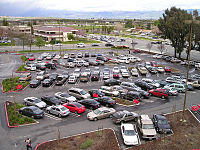User:Labraun90/Impervious surfaces

Impervious surfaces are usually human-made structures—such as pavements that are covered by materials such as asphalt, concrete, brick, stone—and rooftops. Soils compacted by urban development are also highly impervious. Scientists have shown that about 76 percent of the continental United States is made up of less than 1 percent impervious surfaces. 11 percent is 1 to 10 percent impervious surfaces. 4 percent is 11 to 20 percent impervious surfaces. 4.4 percent is 21 to 40 percent impervious surfaces. About 4.4 percent is greater than 40 percent impervious surfaces.[1][2]
References[change | change source]
- ↑ Homer, C., Dewitz, J., Fry, J., Coan, M., Hossain, N., Larson, C., Herold, N., McKerrow, A., VanDriel, J.N., and Wickham, J., 2007, Completion of the 2001 National land cover database for the conterminous United States: Photogrammetric Engineering and Remote Sensing, v. 73, no. 4, p. 337-341.
- ↑ Granato, G.E., 2010, Overview of Methods Used to Estimate Imperviousness in a Drainage Basin Appendix 6 in Methods for development of planning-level estimates of stormflow at unmonitored sites in the conterminous United States: Federal Highway Administration, FHWA-HEP-09-005 "Available on-line." Archived 2015-09-06 at the Wayback Machine
